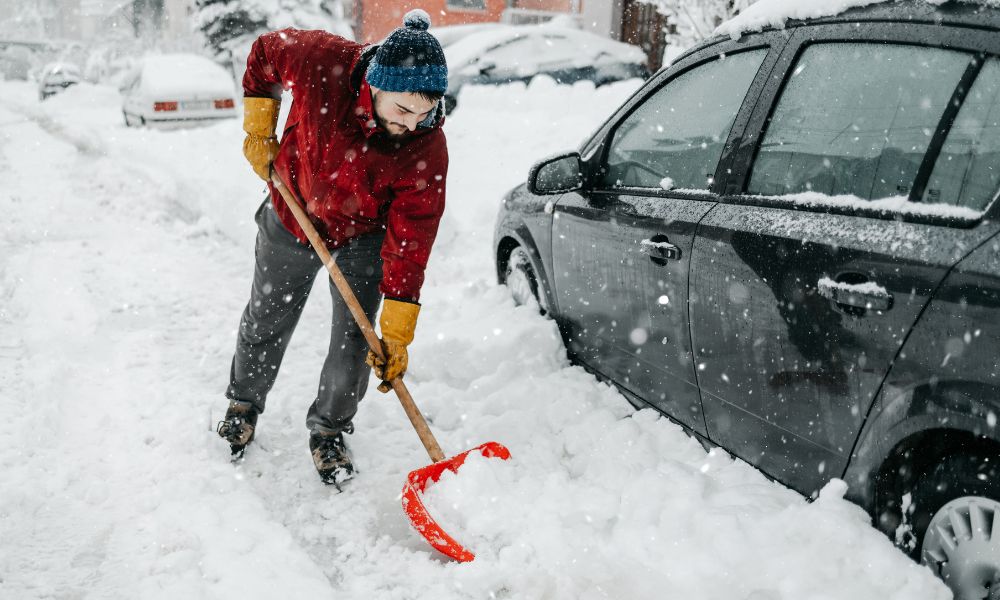It’s a beautiful morning. Fresh snow blankets the ground, transforming the world outside into a magical winter wonderland. You savor the peaceful moment—until you remember the sidewalks and driveway need clearing. Goodbye magic, hello back-breaking chore. Each year, countless people find themselves with injuries from improper snow shoveling techniques.
“Snow shoveling is one of the most physically demanding tasks,” says Ki Hwang, MD, an orthopedic surgeon and spine specialist St. Joseph’s Health. “When done incorrectly, it can put tremendous strain on your lower back, shoulders, and even your heart.”
The good news? With the right preparation and technique, you can tackle your driveway and sidewalks without turning winter chores into a health hazard—and even get some healthy exercise while you’re at it.
Why Shoveling Snow Is Hard on Your Back
Snow shoveling combines heavy lifting with repetitive bending and twisting—movements that put your spine at risk. Add cold temperatures, which tighten muscles and reduce flexibility, and it’s easy to see how injuries happen.
Dr. Hwang explains, “Your spine is like the foundation of a house. If you overload it with poor posture or improper mechanics, it can lead to strains, sprains, or even herniated discs.”
Before You Begin: Preparation Is Key
Like any workout, warming up and preparing your body is crucial:
- Stretch first: Take 5–10 minutes to loosen your muscles. Focus on dynamic stretches, like arm circles and gentle side bends.
- Dress for the weather: Wear layered, moisture-wicking clothing and sturdy, non-slip boots to prevent falls.
- Choose the right shovel: Use a lightweight, ergonomic snow shovel with a curved handle. It reduces the need for excessive bending.
- Stay hydrated: Keep in mind, this is exercise, so don’t forget to hydrate. Drink water before and after your shoveling session, even if you don’t feel thirsty.
The Right Way to Shovel Snow
Dr. Hwang stresses that proper form can prevent back pain and injuries:
- Push, don’t lift: Whenever possible, push the snow rather than lifting it. Pushing minimizes strain on your back.
- Lift smart: If lifting is necessary, bend your knees, not your waist. Use your legs to lift, keeping the shovel close to your body.
- Avoid twisting: Pivot your entire body to throw snow rather than twisting your torso.
- Take breaks: Shoveling is an intense workout. Stop every 10–15 minutes to rest and stretch.
Pace Yourself to Prevent Injury
Snow shoveling is a marathon, not a sprint. Dr. Hwang advises breaking the task into smaller sections to avoid overexertion. “People often try to tackle it all at once, which can lead to fatigue and poor form,” he says. “Clearing smaller areas at a time is safer and more manageable.”
Protect Your Heart While Protecting Your Back
Shoveling snow can also increase the risk of heart attacks, especially in older adults or those with pre-existing conditions. Dr. Hwang offers these precautions:
- Avoid shoveling right after eating or smoking.
- Pay attention to signs of overexertion, such as chest pain, shortness of breath, or dizziness.
- Know your limits and stop if you feel unwell.
A Few More Tips for Snow Shoveling Success
To make snow shoveling safer and more manageable, keep these additional tips in mind:
- Shovel while the snow is fresh: Snow is lighter and easier to move right after it falls. Waiting too long can make it heavier and more difficult to shovel.
- Watch for ice: There may be ice hidden under the snow, so tread carefully to avoid slips and falls.
- Skip the cotton: Avoid wearing cotton clothing next to your skin. If you sweat, it can trap moisture and make you colder.
- Bundle up extremities: Wear gloves, a hat, and warm boots to protect your hands, feet, and face—areas most prone to frostbite.
- Listen to your body: If you start feeling tired or overworked, take a break. Go inside, warm up with some hot cocoa, and return to shoveling when you’re ready.
- Keep your phone nearby: In case of a fall or medical emergency, have your phone handy to call for help if needed.
What If You Feel Pain After Shoveling?
Despite your best efforts, you might still experience soreness. Here’s what to do:
- Apply ice: Use an ice pack on the affected area for 20 minutes at a time to reduce inflammation.
- Stretch gently: Focus on stretches that lengthen your spine.
- Rest: Give your muscles time to recover before returning to strenuous activities.
- Seek help if necessary: If pain persists for more than a few days or becomes severe, consult a doctor.
When to Call the Snow Removal Pros
Sometimes, shoveling snow just isn’t worth the risk. Consider hiring a professional service or enlisting help from neighbors, especially if you have a history of back pain or heart conditions.
A Final Word on Back Safety
Shoveling snow doesn’t have to be a pain in the back—literally. With a little preparation, proper technique, and awareness of your body, you can tackle winter’s toughest task without injury.
“Remember, your health is more important than a clear driveway,” Dr. Hwang advises. “Listen to your body, and don’t hesitate to ask for help when you need it.”
Stay safe, stay warm, and enjoy the beauty of winter pain-free!







